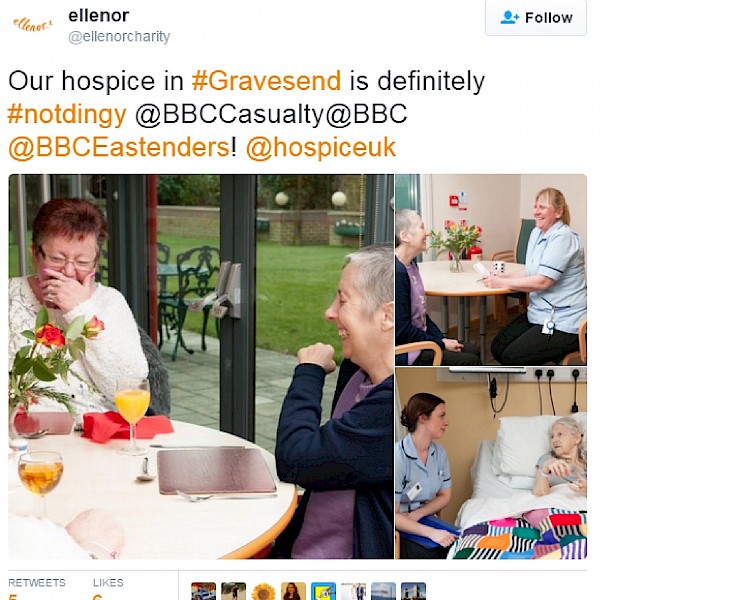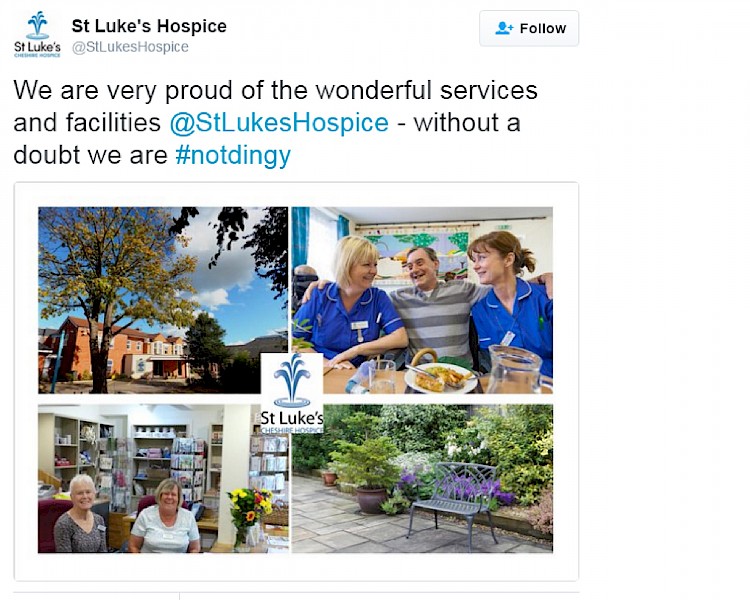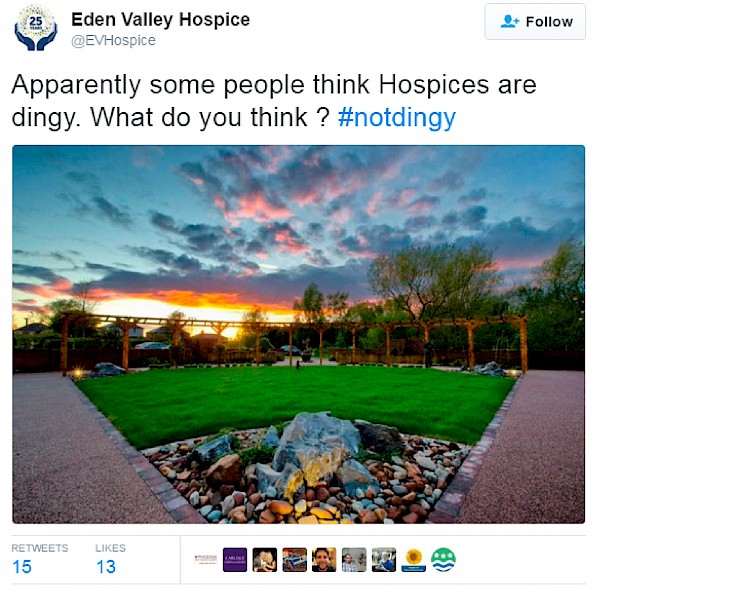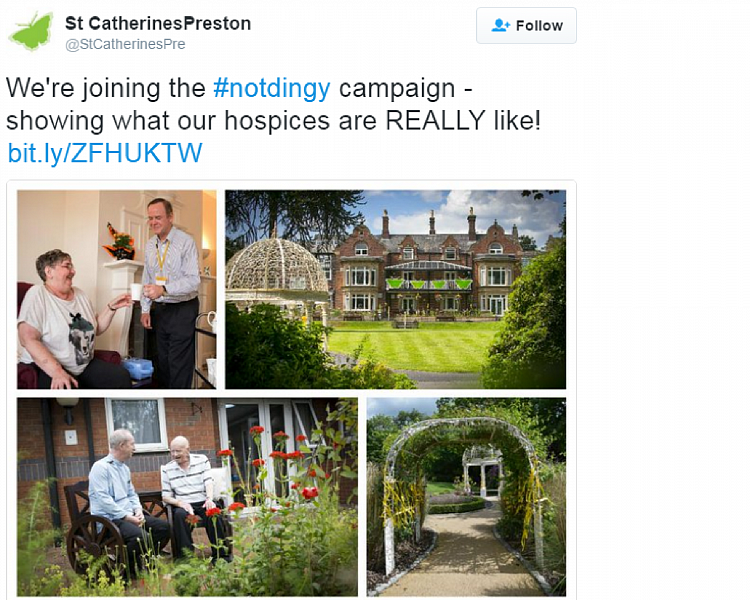Images of hospices on social media
The #notdingy campaign
—
In June 2015, hospices were described as ‘dingy’ on two popular British television dramas. This spurred a social media protest using the hashtag #notdingy. Images were a central component of the #notdingy campaign, which asserted that hospices are positive places in which to be cared for, in many cases until death. In this essay I analyse both the formal qualities of these images as well as their encoded meanings and symbolism (Pauly 2005). I argue that the value of these kinds of images lies less in what is actually depicted than in the images’ affective or emotional force, which can absorb particular meanings and symbolism in the context of a social media campaign.
In the United Kingdom, the term ‘hospice’ is used to refer both to a specific kind of holistic, patient-centred care that is offered alongside or instead of curative treatment, and to the setting in which this kind of care is provided. While hospice care is highly valued in the UK (National End of Life Care Intelligence Network 2013), hospices are nevertheless often perceived by the public as marginal and dirty spaces that house the disintegrating bodies of the sick and dying (Lawton 2000). In the summer of 2015, these views were reflected in episodes of two popular British Broadcasting Corporation (BBC) television dramas, ‘EastEnders’ and ‘Casualty’, in which different characters referred to hospices as ‘grotty’ and ‘dingy’ places. In response, several hospice workers and supporters took to social media (primarily Twitter) to chastise the BBC for these remarks and to share an alternative ‘reality’ about the experience of living and working in hospices (Images 1 & 2). For example, commenting on the need for the campaign in an online news article, a hospice worker claimed that the hospices depicted on the BBC television dramas were ‘not like any of the hospices I know’ (Youlden 2015). HospiceUK, a national charity supporting hospices, quickly backed these efforts (Ellis 2015). The organization encouraged hospices across the country to join the campaign by using the #notdingy hashtag and sharing images of their hospices on Twitter, in order to shift public understandings and narratives about hospices.
 1. One of the few tweets shared as part of the #notdingy campaign that includes an image of someone in bed (bottom right)
1. One of the few tweets shared as part of the #notdingy campaign that includes an image of someone in bed (bottom right)
Ramanathan (2007) argues that images have interventionist capabilities because of their ability to interrupt thoughts and evoke stories. Indeed, the images posted as part of the #notdingy campaign were intended to subvert popular understandings of hospices as dull, dark, and dirty. Interestingly, this was achieved primarily through the use of highly generic, promotional-style ‘stock’ images featuring the exteriors and interiors of particular facilities. Photographs of the grounds frequently featured scenes of brightly coloured sunsets, historical buildings, and well-maintained gardens (Image 3). Photographs of people smiling and interacting were in many ways equally generic, although details like nurses’ uniforms and hospital beds did reflect that these were spaces of medical care.
There were obvious omissions in the photographs posted as part of the #notdingy campaign, such as images of very sick or actively dying people, or those who are obviously grieving. There is no trace of the leaky or contorted bodies, sunken faces, or tears of grief that many people associate with hospices (Lawton 2000). These omissions reveal the highly selective ways in which people and institutions present themselves and their arguments through social media (Miller et al. 2016). They also reflect an explicit challenge to the popular connection between hospices, dying, and death, arguably shifting the focus instead to hospices as places of beauty and care.
Given the omission of very sick, actively dying, and grieving people, viewers might have found it difficult to ‘place’ many of the images that were posted as a part of the #notdingy campaign without the accompanying 140 characters of text and hashtag (especially if the images did not include patients or medical staff and equipment). After all, this was just one more shared sunset or garden photograph that reflects the ‘mundane ordinary aesthetics’ of images posted on social media (Miller et al. 2016). Taken alone, then, the images posted as part of the #notdingy campaign would not have been able to interrupt viewers’ negative notions of hospices or evoke alternate stories. However, posters encoded these generic images with particular meanings and symbolism through the accompanying 140 characters of text, which frequently asserted the images’ ability to depict what hospices are ‘really’ like (Images 4). It was through this combination of generic images and textual truth claims that posters re-presented hospices as ‘beautiful’, ‘helpful’, ‘supportive’, ‘wonderful’, and ‘excellent’ places of care (Image 5). This re-presentation depended not so much on the formal and highly generic content of the images, but rather on their affective or emotional force (Vokes 2008) – that is, the images’ ability to convey a general sense of emplaced warmth, brightness, and serenity, which posters then explicitly or implicitly connected to the provision of high quality, dignified care.
In spite of the generic quality of many of the images posted, the #notdingy campaign successfully shifted BBC practice. Within five days, nearly one hundred Twitter accounts were using the #notdingy hashtag, including hospices in other countries. Multiple small local presses covered the campaign and some members of Parliament tweeted their support. As a direct result of this campaign, by March 2016 the drama department at the BBC had shifted its descriptions of hospices; the local, fictional hospice in ‘Casualty’ was referred to as having lovely gardens and a ‘mean G&T’ (gin and tonic). This change was facilitated through a new consulting relationship between HospiceUK and the BBC drama department that resulted from the campaign. As such, the campaign could be considered a successful example of online activism.
In conclusion, the #notdingy campaign set out to portray what hospices are ‘really’ like through social media posts that featured markedly different visual representations of hospices than those provided in popular BBC television programmes. Generic images of buildings and natural scenes were used to evoke a sense of brightness, calm, and serenity, encouraging the viewer to infer that beautiful gardens, sunsets, and historic buildings translate into high quality, dignified hospice care. The relative absence of dying and grief in these images privileges viewing hospices as places of care rather than death.
About the author
Erica Borgstrom is a lecturer in medical anthropology and end-of-life care at the Open University. Her research examines ‘core concepts’ in palliative and end-of-life care in England, and ethnographically examines how they vary across policy, health care practice, and people’s everyday experiences with terminal illness. She is currently the membership secretary for the Association for the Study of Death and Society (www.deathandsociety.org) and co-convenor of the British Sociological Association’s Social Aspects of Death, Dying and Bereavement study group. Time for this essay was supported by the Foundation for the Sociology of Health and Illness Mildred-Blaxter Postdoctoral Fellowship.
References
Ellis, Jonathan. 2015. ‘The BBC Drama Department Is a Terrible Place to Die’. The Huffington Post. http://www.huffingtonpost.co.uk/jonathan-ellis/hospice-care_b_7552398.html.
Lawton, Julia. 2000. The Dying Process: Patients’ Experiences of Palliative Care. London: Routledge.
Miller, Daniel, Elisabetta Costa, Nell Haynes, Tom McDonald, Razvan Nicolescu, Jolynna Sinanan, Juliano Spyer, Shriram Venkatraman, and Xinyuan Wang. 2016. ‘How the World Changed Social Media,’ January. London: UCL Press. http://www.oapen.org/search?identifier=604151.
National End of Life Care Intelligence Network. 2013. ‘What We Know Now 2013: New Information Collated by the National End of Life Care Intelligence Network’. http://www.endoflifecare-intelligence.org.uk/resources/publications/what_we_know_now_2013.
Pauly, Nancy. 2005. ‘Abu Ghraib: (Un)becoming Photographs: How Can Art Educators Address Current Images from Visual Culture Perspectives?’ Journal of Social Theory in Art Education 25, no. 1. http://scholarscompass.vcu.edu/jstae/vol25/iss1/12.
Ramanathan, Vaidehi. 2007. ‘Photos as Narratives, Photos with Narratives: Alternate Textualities, Minority Histories and Indian Historiography’. Journal of Contemporary Thought 26: 39–56.
Vokes, Richard. 2008. ‘On Ancestral Self-Fashioning: Photography in the Time of AIDS’. Visual Anthropology 21, no. 3: 345–63.
Youlden, Mary. 2015. ‘Hospiscare Complains to BBC about “Grotty” Hospice Storyline in EastEnders’. Exeter Daily, 7 May. http://www.theexeterdaily.co.uk/news/world-news/hospiscare-complains-bbc-about-“grotty”-hospice-storyline-eastenders.



